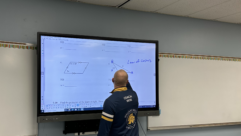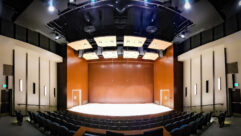
Making Your Case
Aug 17, 2010 12:00 PM,
By Don Kreski
How to use video case histories to sell your services to potential clients.

Chicago-based freelance videographer Bill Youmans uses a Sony DSR-PD170 DVCAM to make professional-level case history videos for his clients.
“It’s important that we find ways to communicate the quality of the work we do—not just with our usual marketing brochures, but with something more interactively appealing.” That’s what Candace Clarke, communications editor for AVI-SPL in Tampa, Fla., says about three new video case histories she produced for the company’s website.
The videos, focusing on AVI-SPL customers, went online in April and May, and each has already been watched by 400 to 1300 potential customers. “We encourage our salespeople to use these as resources when they’re talking with potential clients,” she adds. Still, most viewers find them on their own on YouTube, on an educational site called TeacherTube, or via the Google Videos search engine. Clarke says the videos have helped to bring web traffic to the main AVI-SPL site and raise its ranking in the search engines.
As much as our industry is involved with visual presentations, it’s surprising how rarely this type of video is produced by an AV firm.
Related Links

AV Systems at Ringling College of Art and Design
A tour of innovative HD technologies at Ringling College of Art and Design’s new Academic Building in Sarasota…

SMART Boards Increase Interactivity at Academy at the Farm Charter School
AVI-SPL recently equipped Academy at the Farm with SMART’s 680i interactive whiteboards and Elmo document cameras…

AV Systems at USF Marshall Student Center
University of South Florida (USF) Marshall Center’s Assistant Director of Operations, Jennifer Hernandez, takes us on a tour of the latest in higher education AV systems…

Bill Youmans, a freelance videographer from Chicago, created this case history video for AMX…
It takes some effort
When I say that this type of video is rare, I realize that many AV sales and marketing people are experimenting with quickly made, amateur-quality videos posted on their websites or on the social media sites. While that kind of video has its place, the three AVI-SPL case histories do not fit in this category. They are professionally produced, with good lighting, sound, camera work, and editing. Most important, they were carefully planned and tell a coherent, interesting story about each installation.
“The most important thing, in my mind, is the story” says Bill Youmans, a freelance videographer from Chicago. I met him about four years ago when, based on a recommendation, I brought him in to produce two video case histories for AMX.
“A client once asked me, ‘How do we do this?'” he explains. “Well, we do some in-depth interviews and we find out what the story is. If I’m shooting an AV installation, I’ll ask, ‘What works? What doesn’t? Why did you do it like this?’ I’ll look for the positives and the pitfalls, and I’ll try to find some human interest. As people, we all want to know what the story is and how this story relates to us. If it sparks just one good idea, then it’s worth watching.”
In shooting his videos, Youmans is careful to use good equipment: Sony CineAlta, Panasonic AG-HVX170, and Red Digital Cinema Red One cameras; Sennheiser and Lectrosonics microphones; and supplementary lighting from Arri and Kino Flo. Unlike some of today’s videographers, he almost always uses a tripod. But for him, what’s crucial is the story, the people he interviews and how he can get them to open up.
Clarke addressed each of these issues as well for the AVI-SPL videos. First, she hired a professional videographer—from Tampa-based production company BuzzMedia—to handle the camera and editing work.
She took charge of the content herself. “We wrote out questions and sent them to our clients so they could prepare for the interviews,” she says. She says she had a good idea of what she would find at each installation, but “the first thing we did when we arrived was take a tour of the facility and plan our B-roll.”
None of these videos use professional talent, but to describe the speakers as amateur would not be accurate. “They were all people who have a real knowledge and passion about AV systems, and that came through in the videos,” Clarke says. “They were well-versed on the technology, on what works and what doesn’t, and they were comfortable speaking about their goals.”
Clarke also tried to include an interview of the primary AVI-SPL client contact in each video. Sales Engineer Jamie Knoop, featured in the Ringling College of Art and Design production, was especially impressive. “He was able to give us all the details on the technology we needed and demonstrate how it helped to meet specific client goals,” Clarke says. “When a potential client sees the video, we hope that they get a sense of how highly skilled and dedicated we are when it comes to supporting their needs.” Obviously some people will be better on camera than others, but you often have a choice of who to include, and you can certainly shoot more than one take, so that you’ll be able to choose only the best of the comments they make.
Making Your Case
Aug 17, 2010 12:00 PM,
By Don Kreski
How to use video case histories to sell your services to potential clients.
Tricks of the trade
Youmans says there’s a trick to getting people who are not professional actors to look good on camera. “You have to warm them up,” he says. Start talking to them as soon as you can on a personal level.
Once you have your camera and lights working, keep talking to them, but get the video rolling as soon as possible and keep it rolling. “I generally ask the same question more than once during the course of an interview, sometimes five or six times if it’s an important question,” Youmans says. “They’ll answer it differently each time, and often their answers will get more interesting and more succinct as the conversation goes on.”
Related Links

The key to making good decisions is starting with good information. That’s an area where marketing managers in the natural and organic foods industry have a big advantage over those of us working in AV. They can use cash register scanner data to model buyer behavior, rather than relying on surveys, samples, and other means of estimating sales and market share…

One of the most important ways you can connect with potential customers is through your website, and one of the fastest ways to turn them off is with poor design. What makes the difference? …

There’s an art and a science to writing winning proposals. The science will help you make sure the document you submit will realistically describe what you plan to do…
Be sure to listen carefully to what the person you’re interviewing says so you can follow through with more questions. “A good interview is more like a conversation,” Youmans says. “We always start out with prepared questions, but once you start talking, you never know exactly what you’re going to get. Sometimes you’ll get some very nice statements that you never would expect.”
No matter what you do, some people won’t look good on video. “Everyone is nervous starting out,” Youmans says. “Most will warm up, but some don’t.” For that reason, it’s best to have more than one person on hand to interview. If you plan to use the IS director at a corporate customer, try to line up the facility manager as well.
“We assured each of our end users that we would cut any uncomfortable moments when we edited the videos,” Clarke adds. “If someone had trouble, we tried to keep their segments shorter.”
How much video should you expect to shoot? Youmans says you should record 5 to 30 minutes of video for every minute you use, with a ratio of 20:1 to 30:1 common for a film or television documentary. For a 6-minute video he recently completed, he shot 15 hours of tape over a two-day period. This shoot included interviews plus video of his client’s products in action—in this case, commercial trucks. “Tape is very cheap,” Youmans says. “You’re going to have to edit it no matter what, and truly the more you have to work with, the better your final product is going to be.”
Clarke says that for each of the AVI-SPL video case histories, she spent a full day onsite interviewing customers and reps and shooting B-roll of their AV systems. Youmans also spent most of a day on site for each of his AMX videos.
It’s possible to shoot your own video and get good results, but most people should plan to hire a videographer to help. There’s a lot to keep in mind. You will probably shoot conference rooms and classrooms using available lighting, but more than likely, you’ll need to supplement that lighting when you position your customer for an interview. You need good sound. You need good color. You will absolutely need to edit what you shoot, so you will need some expertise in Apple Final Cut Pro, Adobe Premiere Pro, or a similar program, and you will need to spend a lot of time in the editing process.
With careful planning and, most likely, some professional help, your company can produce its own video case histories. If you do, I think you’ll find them a powerful addition to your marketing program. “We have found that these video are definitely a great tool,” Clarke says, “We plan to do more of them.”
Don Kreski is the president of Kreski Marketing Consultants, which offers marketing services to the AV industry. You can reach him at www.kreski.com/contact.html.










